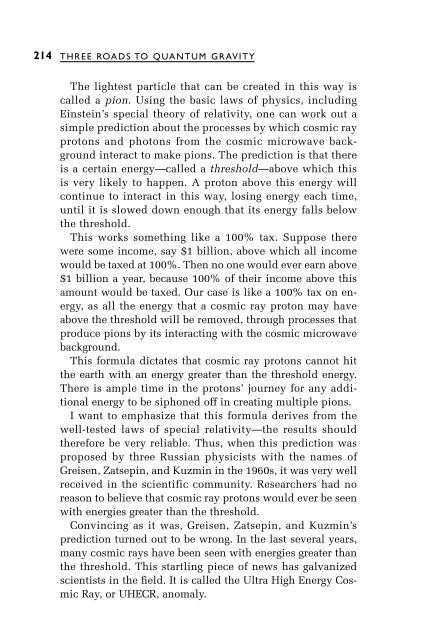Three Roads To Quantum Gravity
Three Roads To Quantum Gravity
Three Roads To Quantum Gravity
You also want an ePaper? Increase the reach of your titles
YUMPU automatically turns print PDFs into web optimized ePapers that Google loves.
214<br />
THREE ROADS TO QUANTUM GRAVITY<br />
The lightest particle that can be created in this way is<br />
called a pion. Using the basic laws of physics, including<br />
Einstein’s special theory of relativity, one can work out a<br />
simple prediction about the processes by which cosmic ray<br />
protons and photons from the cosmic microwave background<br />
interact to make pions. The prediction is that there<br />
is a certain energy—called a threshold—above which this<br />
is very likely to happen. A proton above this energy will<br />
continue to interact in this way, losing energy each time,<br />
until it is slowed down enough that its energy falls below<br />
the threshold.<br />
This works something like a 100% tax. Suppose there<br />
were some income, say $1 billion, above which all income<br />
would be taxed at 100%. Then no one would ever earn above<br />
$1 billion a year, because 100% of their income above this<br />
amount would be taxed. Our case is like a 100% tax on energy,<br />
as all the energy that a cosmic ray proton may have<br />
above the threshold will be removed, through processes that<br />
produce pions by its interacting with the cosmic microwave<br />
background.<br />
This formula dictates that cosmic ray protons cannot hit<br />
the earth with an energy greater than the threshold energy.<br />
There is ample time in the protons’ journey for any additional<br />
energy to be siphoned off in creating multiple pions.<br />
I want to emphasize that this formula derives from the<br />
well-tested laws of special relativity—the results should<br />
therefore be very reliable. Thus, when this prediction was<br />
proposed by three Russian physicists with the names of<br />
Greisen, Zatsepin, and Kuzmin in the 1960s, it was very well<br />
received in the scientific community. Researchers had no<br />
reason to believe that cosmic ray protons would ever be seen<br />
with energies greater than the threshold.<br />
Convincing as it was, Greisen, Zatsepin, and Kuzmin’s<br />
prediction turned out to be wrong. In the last several years,<br />
many cosmic rays have been seen with energies greater than<br />
the threshold. This startling piece of news has galvanized<br />
scientists in the field. It is called the Ultra High Energy Cosmic<br />
Ray, or UHECR, anomaly.



![arXiv:1001.0993v1 [hep-ph] 6 Jan 2010](https://img.yumpu.com/51282177/1/190x245/arxiv10010993v1-hep-ph-6-jan-2010.jpg?quality=85)


![arXiv:1008.3907v2 [astro-ph.CO] 1 Nov 2011](https://img.yumpu.com/48909562/1/190x245/arxiv10083907v2-astro-phco-1-nov-2011.jpg?quality=85)








![arXiv:1002.4928v1 [gr-qc] 26 Feb 2010](https://img.yumpu.com/41209516/1/190x245/arxiv10024928v1-gr-qc-26-feb-2010.jpg?quality=85)
![arXiv:1206.2653v1 [astro-ph.CO] 12 Jun 2012](https://img.yumpu.com/39510078/1/190x245/arxiv12062653v1-astro-phco-12-jun-2012.jpg?quality=85)
